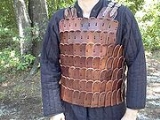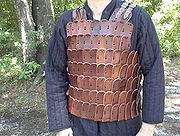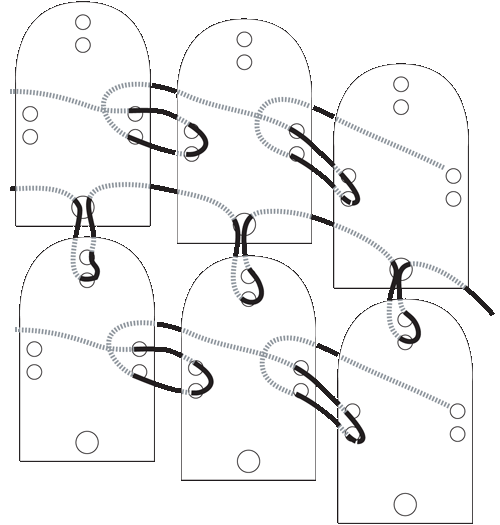
Lamellar armour
Encyclopedia

Scale armour
Scale armour is an early form of armour sometimes erroneously called scale mail consisting of many individual small armour scales of various shapes attached to each other and to a backing of cloth or leather in overlapping rows. Scale armour was worn by warriors of many different cultures as well...
and laminar armour
Laminar armour
Laminar armour , sometimes confusingly referred to as "banded mail", is an armour made from horizontal overlapping rows of solid armour plates as opposed to lamellar armour which is made from individual armor scales laced together to form a solid looking strip of armor.Prominent examples of such...
.
Description

Scale armour
Scale armour is an early form of armour sometimes erroneously called scale mail consisting of many individual small armour scales of various shapes attached to each other and to a backing of cloth or leather in overlapping rows. Scale armour was worn by warriors of many different cultures as well...
, from which it differs by not needing a backing for the scales. When the lames are made of leather they can be hardened by a process such as cuir bouilli
Boiled leather
Boiled leather, sometimes called cuir bouilli, was a historical construction material for armour. It consists of thick leather, boiled in water . The boiling causes the leather to be harder but more brittle...
or lacquering.
Use and history
Lamellar armour was often worn as augmentation to existing armour, such as over a mail hauberkHauberk
A hauberk is a shirt of chainmail. The term is usually used to describe a shirt reaching at least to mid-thigh and including sleeves. Haubergeon generally refers to a shorter variant with partial sleeves, but the terms are often used interchangeably.- History :The word hauberk is derived from the...
. The lamellar cuirass
Cuirass
A cuirass is a piece of armour, formed of a single or multiple pieces of metal or other rigid material, which covers the front of the torso...
was especially popular with the Rus
Rus' (people)
The Rus' were a group of Varangians . According to the Primary Chronicle of Rus, compiled in about 1113 AD, the Rus had relocated from the Baltic region , first to Northeastern Europe, creating an early polity which finally came under the leadership of Rurik...
, as well as Mongols
Mongols
Mongols ) are a Central-East Asian ethnic group that lives mainly in the countries of Mongolia, China, and Russia. In China, ethnic Mongols can be found mainly in the central north region of China such as Inner Mongolia...
, Turks
Turkic peoples
The Turkic peoples are peoples residing in northern, central and western Asia, southern Siberia and northwestern China and parts of eastern Europe. They speak languages belonging to the Turkic language family. They share, to varying degrees, certain cultural traits and historical backgrounds...
, Avars
Eurasian Avars
The Eurasian Avars or Ancient Avars were a highly organized nomadic confederacy of mixed origins. They were ruled by a khagan, who was surrounded by a tight-knit entourage of nomad warriors, an organization characteristic of Turko-Mongol groups...
, and other steppe peoples, as it was simple to create and maintain.
Lamellar is pictured in many historical sources on Byzantine
Byzantine Empire
The Byzantine Empire was the Eastern Roman Empire during the periods of Late Antiquity and the Middle Ages, centred on the capital of Constantinople. Known simply as the Roman Empire or Romania to its inhabitants and neighbours, the Empire was the direct continuation of the Ancient Roman State...
warriors, especially heavy cavalry
Heavy cavalry
Heavy cavalry is a class of cavalry whose primary role was to engage in direct combat with enemy forces . Although their equipment differed greatly depending on the region and historical period, they were generally mounted on large powerful horses, and were often equipped with some form of scale,...
. It is thought that it was worn to create a more deflective surface to the rider's armour, thus allowing blades to skim over, rather than strike and pierce. Recent studies by Timothy Dawson of the University of New England, Australia
University of New England, Australia
The University of New England is an Australian public university with approximately 18,000 higher education students. Its original and main campus is located in the city of Armidale in northern New South Wales....
, suggest that Byzantine lamellar armour was significantly superior to chain mail.
Sumer
Sumer
Sumer was a civilization and historical region in southern Mesopotamia, modern Iraq during the Chalcolithic and Early Bronze Age....
ian and Ancient Egypt
Ancient Egypt
Ancient Egypt was an ancient civilization of Northeastern Africa, concentrated along the lower reaches of the Nile River in what is now the modern country of Egypt. Egyptian civilization coalesced around 3150 BC with the political unification of Upper and Lower Egypt under the first pharaoh...
ian bas-reliefs depicting soldiers have been argued as portraying the earliest examples of lamellar armour, particularly on chariot drivers, but it is not until the time of the Assyrians
Assyrian people
The Assyrian people are a distinct ethnic group whose origins lie in ancient Mesopotamia...
(circa 900–600 BC) that possible examples of lamellar appear in the archaeological record. Among finds of Assyrian armour (often individual or unconnected scales), there are examples that can clearly be classified as scale armour
Scale armour
Scale armour is an early form of armour sometimes erroneously called scale mail consisting of many individual small armour scales of various shapes attached to each other and to a backing of cloth or leather in overlapping rows. Scale armour was worn by warriors of many different cultures as well...
as well as others that appear to be lamellar, and there exist a large number of finds whose function has proven difficult to determine.
The extent to which either type was used is a debated topic. The earliest definite instance of true lamellar was found in China
China
Chinese civilization may refer to:* China for more general discussion of the country.* Chinese culture* Greater China, the transnational community of ethnic Chinese.* History of China* Sinosphere, the area historically affected by Chinese culture...
. Twelve suits of lacquered lamellar dated to c. 433 BC were uncovered in a tomb at Sui-hsien, Hupei. Lamellar was used by various cultures from this time up through the 16th century. Lamellar armour is generally associated with the armour worn by the samurai
Samurai
is the term for the military nobility of pre-industrial Japan. According to translator William Scott Wilson: "In Chinese, the character 侍 was originally a verb meaning to wait upon or accompany a person in the upper ranks of society, and this is also true of the original term in Japanese, saburau...
class of feudal Japan, although it came to Japan from Korea.Lamellar armour is also associated with Mongolia
Mongolia
Mongolia is a landlocked country in East and Central Asia. It is bordered by Russia to the north and China to the south, east and west. Although Mongolia does not share a border with Kazakhstan, its western-most point is only from Kazakhstan's eastern tip. Ulan Bator, the capital and largest...
, Eastern Russia
Eastern Russia
Eastern Russia may refer to:*Siberia*Russian Far East...
, the tribes of Siberia
Siberia
Siberia is an extensive region constituting almost all of Northern Asia. Comprising the central and eastern portion of the Russian Federation, it was part of the Soviet Union from its beginning, as its predecessor states, the Tsardom of Russia and the Russian Empire, conquered it during the 16th...
and the Sarmatians
Sarmatians
The Iron Age Sarmatians were an Iranian people in Classical Antiquity, flourishing from about the 5th century BC to the 4th century AD....
, evidence of lamellar armour has also been found in various European countries.
Japanese lamellar armour
Lamellar armour reached Japan around the 5th century. The pre-samurai Japanese lamellar armour was called keiko. These early Japanese lamellar armours took the form of a sleeveless jacket and a helmet. The middle of the Heian periodHeian period
The is the last division of classical Japanese history, running from 794 to 1185. The period is named after the capital city of Heian-kyō, or modern Kyōto. It is the period in Japanese history when Buddhism, Taoism and other Chinese influences were at their height...
was when Japanese lamellar armor started to take the shape that would be associated with samurai armour. By the late Heian period Japanese lamellar armour developed into full-fledged samurai armour called Ō-yoroi
O-yoroi
The Ō-Yoroi is a prominent example of early Japanese armor worn by the samurai class of feudal Japan. The term ō-yoroi means "great armor."-History:...
. Japanese lamellar armours were made from hundreds or even thousands of individual leather and or iron scales (kozane) that were lacquered and laced together into armor strips. This was a very time consuming process. The two most common types of scales which made up the Japanese lamellar armors were hon kozane, which were constructed from narrow or small scales, and hon iyozane, which were constructed from wider scales.
See also
- Chinese armourChinese armourChina has a long history of armour and weapons development. China has many varieties of armour, but the most were of the lamellar, coat of plates, brigandine and scaled varieties.-Ancient Armor: Shang to Han:Initially, armour was exclusively for nobles...
- Korean armourKorean armourKorean armour is the armour used traditionally in ancient times against swords in swordfighting, and as well in other battlefield encounters by Koreans or those fighting in Korea, or Korean fighting overseas...
- Japanese armourJapanese armourArmour in Japan has a history that goes back as far as the 4th century. Japanese armour developed enormously over the centuries since its introduction to the battlefield. It was worn to varying degrees by numerous classes; most notably by the Samurai , and was seen on the battlefield both on...
- Mongolian armourMongolian armourMongolian armour has a long history. Mongol armour drew its influence from Chinese and Middle East styles. Most Mongolian armour was of scale and lamellar variety. Most armour was made of hardened leather and iron, lanced together onto a fabric backing, sometimes silk. Mail armour was also...
- Russian ArmourPlated mailPlated mail is a type of mail with embedded plates. Armour of this type has been used in the Middle East, Japan, China, Korea, Central Asia, Greater Iran, India, Eastern Europe, and by the Moors.-Types of plated mail:In Russia there are three known varieties of this armour...
- Viking ArmourViking Age arms and armourKnowledge about arms and armour of the Viking Age is based on relatively sparse archaeological finds, pictorial representation, and to some extent on the accounts in the Norse sagas and Norse laws recorded in the thirteenth century.According to custom, all free Norse men were required to own...
- Laminar armourLaminar armourLaminar armour , sometimes confusingly referred to as "banded mail", is an armour made from horizontal overlapping rows of solid armour plates as opposed to lamellar armour which is made from individual armor scales laced together to form a solid looking strip of armor.Prominent examples of such...
- Scale armourScale armourScale armour is an early form of armour sometimes erroneously called scale mail consisting of many individual small armour scales of various shapes attached to each other and to a backing of cloth or leather in overlapping rows. Scale armour was worn by warriors of many different cultures as well...

